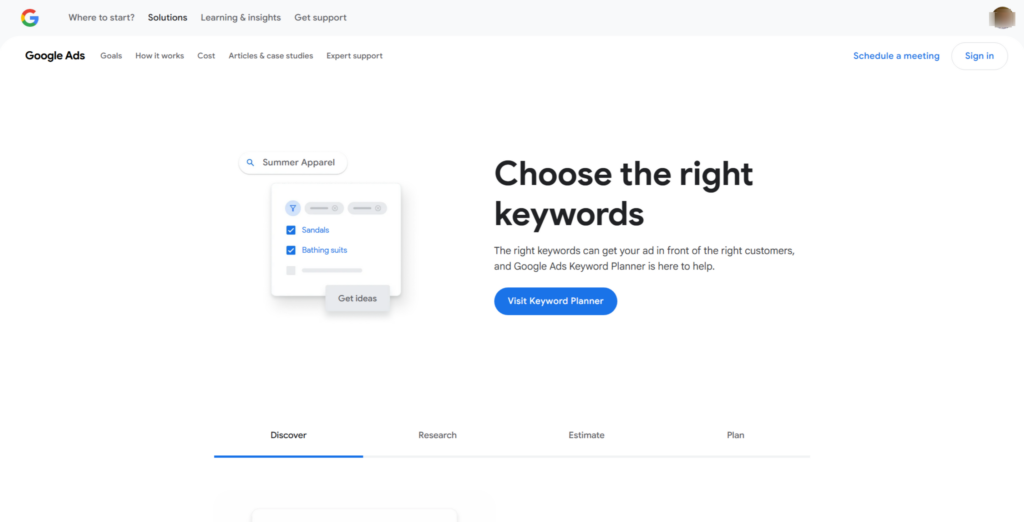At Key Brains, we believe that a smart digital strategy begins with one crucial decision—choosing the right keywords. Whether you’re creating content for a personal blog, optimizing a high-traffic service page, or managing a complex e-commerce website, your success in search engine optimization (SEO) is fundamentally rooted in how effectively you conduct keyword research and implementation.
The right keywords serve as the bridge between what people are searching for and the content you’re offering. When chosen and used wisely, they can significantly elevate your visibility, attract the right audience, and increase engagement. A strategic approach to keywords doesn’t just help you get seen—it helps you get seen by the people who matter most to your business.
Key Steps to Finding Keywords That Drive Real Results
Let’s explore, in detail, the key steps to finding keywords that drive real results.
1. Think Like Your Audience

Before diving into any keyword tool, it’s critical to first put yourself in your customer’s shoes. Think deeply about what your target audience is genuinely curious about. What specific problems are they trying to solve? What language, terminology, or phrases do they use when searching online? Understanding these patterns of thought is fundamental to successful keyword research.
At Key Brains, we encourage clients to begin by identifying core topics that resonate with their business niche. These themes represent the categories your audience cares about and provide a structured foundation for deeper keyword exploration. Conduct informal interviews, review social media discussions, analyze FAQs, and even observe competitor content to uncover authentic audience language.
Additionally, focus on understanding search intent—the underlying reason behind a user’s query. For instance, someone searching “how to fix a leaky faucet” likely seeks a practical, step-by-step guide rather than a promotional product page. This insight helps you create content that directly aligns with user needs, resulting in better engagement and stronger search engine rankings.
2. Use Tools to Uncover Keyword Gold
While brainstorming ideas is a great first step, validating those ideas with real data is what separates guesswork from smart strategy. Keyword research tools such as Ubersuggest, SEMrush, Ahrefs, and Google Keyword Planner offer detailed insights into the search behavior of real users.

Image source
These platforms can show you exactly what people are typing into search engines and how frequently. At Key Brains, we advise paying close attention to three core metrics: search volume, SEO difficulty, and competition. Search volume indicates how popular a term is and whether it’s worth targeting. SEO difficulty tells you how hard it will be to rank for that keyword—usually influenced by the strength of competing websites.
Competition helps you evaluate if established brands or industry giants already dominate the space. When these metrics are used together, they provide a well-rounded picture of keyword opportunity. The most successful strategies strike a balance: include some high-traffic, broad terms to attract a wide audience, and complement them with more niche long-tail keywords that offer lower competition and higher conversion potential. This blend allows you to build a keyword strategy that is ambitious yet attainable, maximizing both visibility and results.
3. Don’t Sleep on Long-Tail Keywords
Long-tail keywords are an often-overlooked but incredibly powerful component of any SEO strategy. These are keyword phrases that are longer, more specific, and generally used by people further along in their buying journey. For example, a keyword like “headphones” is very broad and could refer to thousands of different products and user intents. In contrast, “best wireless headphones for working out” is specific and clearly communicates what the searcher is looking for.
While the search volume for long-tail keywords is usually lower, the quality of traffic they bring in is much higher. Visitors who use specific phrases like these often have a clear intent—they’re ready to buy, compare, or act. At Key Brains, we emphasize building content around long-tail keywords because they offer an excellent balance between relevance, competition, and conversion potential.
These keywords allow you to serve more defined user needs, improve your chances of ranking in search results, and connect with audiences who are more likely to engage with your brand. By consistently targeting a wide range of long-tail phrases, you also create a content ecosystem that builds authority and trust within your niche.
4. Win the Snippet Game

Featured snippets, also known as “position zero” results, are answer boxes that appear at the top of Google’s search results, often above even the highest-ranked organic listing. These snippets are designed to give users quick, concise answers to their queries, and landing one can dramatically boost your site’s visibility.
To compete for this coveted spot, your content needs to be structured with precision and clarity. Start by identifying common questions your audience might ask, and use these as your subheadings. Under each heading, provide short, direct answers—ideally in a format that Google can easily parse, such as bullet points, tables, numbered lists, or succinct paragraphs. Including schema markup where appropriate can also increase your chances. At Key Brains, we advise writing with both your reader and the algorithm in mind.
A good rule of thumb: if a client asked you a specific question, how would you answer it clearly in one or two sentences? That level of directness is exactly what Google looks for in a featured snippet. Winning the snippet game doesn’t just help with SEO; it also establishes your brand as a trusted authority in your field.
5. Place Keywords with Purpose
Once you’ve carefully selected your keyword list, the next challenge is placing them strategically within your content. The era of keyword stuffing is long gone. Today’s algorithms prioritize relevance, context, and user experience. Keywords need to appear naturally and in the right places to signal relevance to search engines while still providing value to human readers.
At Key Brains, we recommend incorporating your target keyword in key locations: the page title, the main H1 heading, subheadings (H2s and H3s), the first 100 words of the content, image alt tags, and naturally throughout the text body. This creates multiple relevance signals without compromising readability.
Also, use variations and synonyms of your main keyword to support semantic relevance. For example, if your keyword is “digital marketing strategies,” use related terms like “online marketing tactics” or “internet advertising methods.” This not only improves SEO but also makes the content more engaging. Always aim for a natural flow—write for humans first, search engines second. The goal is seamless integration where the keyword enhances rather than disrupts the user experience.
6. Optimize Meta Descriptions to Stand Out

Meta descriptions may not be a direct ranking factor, but they play a crucial role in influencing whether users click on your link. Think of them as your advertisement in the search results.
A compelling meta description should be between 150-160 characters, include your primary keyword, and offer a clear and concise value proposition. At Key Brains, we teach a simple but effective formula: What the user wants + how your content delivers it + a reason to click now. For example: “Discover the top productivity tools for remote teams. Our 2025 guide breaks down features, pricing, and best use cases.”
This snippet tells users exactly what to expect and why they should choose your content over others. Including an emotional or actionable element (like “Boost your team’s efficiency today”) can also improve click-through rates. Regularly updating meta descriptions for underperforming pages can be a low-effort, high-impact way to drive more traffic.
7. Use Headers to Guide the Reader (and Google)

Headings are essential for both user experience and SEO. Proper use of H1, H2, and H3 tags structures your content in a way that’s easy to scan and understand. Your H1 tag should reflect the primary keyword and clearly indicate the topic of the page. Subheadings (H2s and H3s) should logically break down the content into digestible sections, making it easier for readers to navigate and for search engines to index. At Key Brains, we see headers as both organizational tools and strategic SEO elements.
Incorporate secondary or related keywords where it feels natural, and use them to highlight the hierarchy and importance of each section. For example, under an H2 titled “Digital Marketing Channels,” you might include H3s for “Email Marketing,” “Social Media,” and “SEO.” This not only enhances readability but reinforces topic relevance. Think of your headers as a map—they guide readers through your content while signaling structure and context to search engines.
8. Page Speed Still Matters—A Lot
In today’s fast-paced digital world, users expect websites to load quickly. A slow-loading page can frustrate visitors and lead to high bounce rates, negatively impacting both user experience and SEO. Google has explicitly stated that page speed is a ranking factor, especially for mobile users. To ensure your content performs optimally, take proactive steps to improve loading times.
Compress images using tools like TinyPNG, convert them to more efficient formats like WebP, and limit the number of heavy or unnecessary plugins. Enable browser caching, use a content delivery network (CDN), and optimize your website’s code by minimizing CSS, JavaScript, and HTML files. At Key Brains, we routinely run performance audits using Google PageSpeed Insights or GTmetrix and implement both front-end and server-side improvements.

Image source
Fast websites don’t just rank better—they also retain more visitors, reduce abandonment rates, and improve overall satisfaction. Investing in speed optimization ensures that your SEO efforts are supported by a solid technical foundation.
Final Thoughts: Smarter Keywords, Stronger Results
Keyword research is not just a checkbox in your SEO to-do list—it’s the lifeblood of a results-driven digital strategy. From understanding your audience’s intent to using data-backed tools and implementing thoughtful on-page SEO tactics, every step in the keyword journey matters.
At Key Brains, we help businesses tap into meaningful growth by targeting the terms that matter most, crafting content that satisfies user needs, and continually adapting to changes in search behavior. The digital landscape is constantly evolving, but one principle remains constant: smart keyword strategy leads to strong results.
Whether you’re just starting out or looking to refine an existing SEO plan, remember that your next breakthrough might be just one well-researched keyword away. Need guidance? Let’s talk. We’re here to help you unlock the power of smart search marketing.

